750 Gilford Street: A Century-Old Place of Exchange
Text by Annick Desmarais
Author and historian
May 19, 2023
Montreal's 750 Gilford Street has housed various neighbourhood grocery stores over several decades. From the mid-1960s, it was home to various drinking establishments. However, since 2010, thanks to Marché 3 Piliers, it has returned to its original vocation and once again provides tasty food for the delight of its customers.
The Birth of an Important Place (1906-1911)
On July 12, 1906, Mr. Gustave Paré, a carpenter by trade, buys the land on which 750 Gilford Street will later be built. This worker-promoter buys and resells various sites and takes advantage of the rapid expansion of the neighbourhood. In 1903 in fact, most of the streets between Gilford and Laurier are vacant lots: one lone building stands on Gilford Street, between Resther and St-Hubert streets. A few years later, these lots will be entirely occupied by buildings. The popular Saint-Denis district begins to flourish, many potential customers settle in the area and the need for corner grocery stores becomes evident. Thanks to such businesses, housewives can do their shopping on foot or have their groceries delivered to their homes, rather than having to go all the way to the Saint-Jean-Baptiste public market, located on the corner of Saint-Laurent and Rachel, at that time the nearest market to this part of the city.
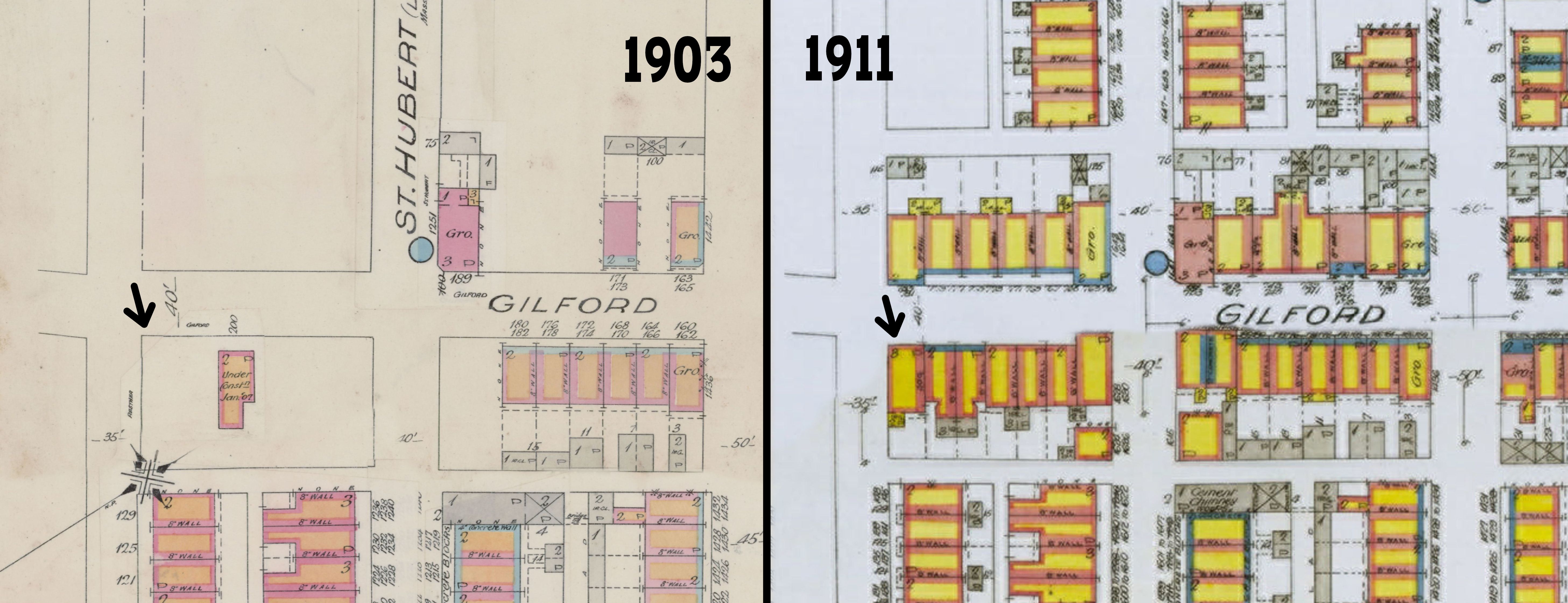 1903-1911 Transformation of the Saint-Denis district and creation, circa 1903-1911, of 750 Gilford Street (the two arrows indicate the location). Source: Carte-index des plans d'assurance-incendie de Montréal, volume 5, BAnQ.
1903-1911 Transformation of the Saint-Denis district and creation, circa 1903-1911, of 750 Gilford Street (the two arrows indicate the location). Source: Carte-index des plans d'assurance-incendie de Montréal, volume 5, BAnQ.
1911-1928: Several First Grocery Stores and Changing Tenants
The civic address 750 Gilford Street first appeared in the Lovell directories in 1911-1912, under the name of the tenant, W. Laflamme. There were several different tenants up until 1928. It is very possible that W. Laflamme opened a grocery store there as early as 1911. However, the first reliable trace known of the existence of a grocery store in operation, without knowing exactly since when, is in October 1924, when Théogène Verville buys the property from Mr. Paré, including the electrical fittings, shelves and the large counter in the grocery store. Two months later, on December 29, a for sale advertisement is published in La Presse: « Épicerie, un coin. Faisant bonnes affaires, fixtures, stock frais, belle cave, cheval, voitures été, hiver, chance à prompt acquéreur. S'ad. 750 Gilford, Belair 0891, prendra propriété en échange ». Subsequently, between 1924 and 1928, various tenants and advertisements to sell a grocery store suggest a steady rotation of managers and grocery stores.
The Tourville Family: A Well-Established Family Business in the Neighbourhood (1928-1963)
On February 2, 1928, Théogène Verville sells the building to François de Sales Tourville (circa 1863 1946), living at 763, Gilford Street. François de Sales Tourville is the father of four sons and four daughters. The custom at the time is to "set up" one's sons. Therefore, after securing a future in agriculture in St-François de Sales (Laval Island) for his two eldest sons, Edouard and Eugène, François may be in search of new opportunities and decides to move to Montreal. Endowed with a strong sense of entrepreneurship, François sees the grocery store across the street for sale and, although he has no experience in the food business, seizes the opportunity for Léopold, his third son. It is a sign of the success of his decision that he repeats the exercise a few years later and acquires a grocery store on Beaubien for Arthur, his youngest son.
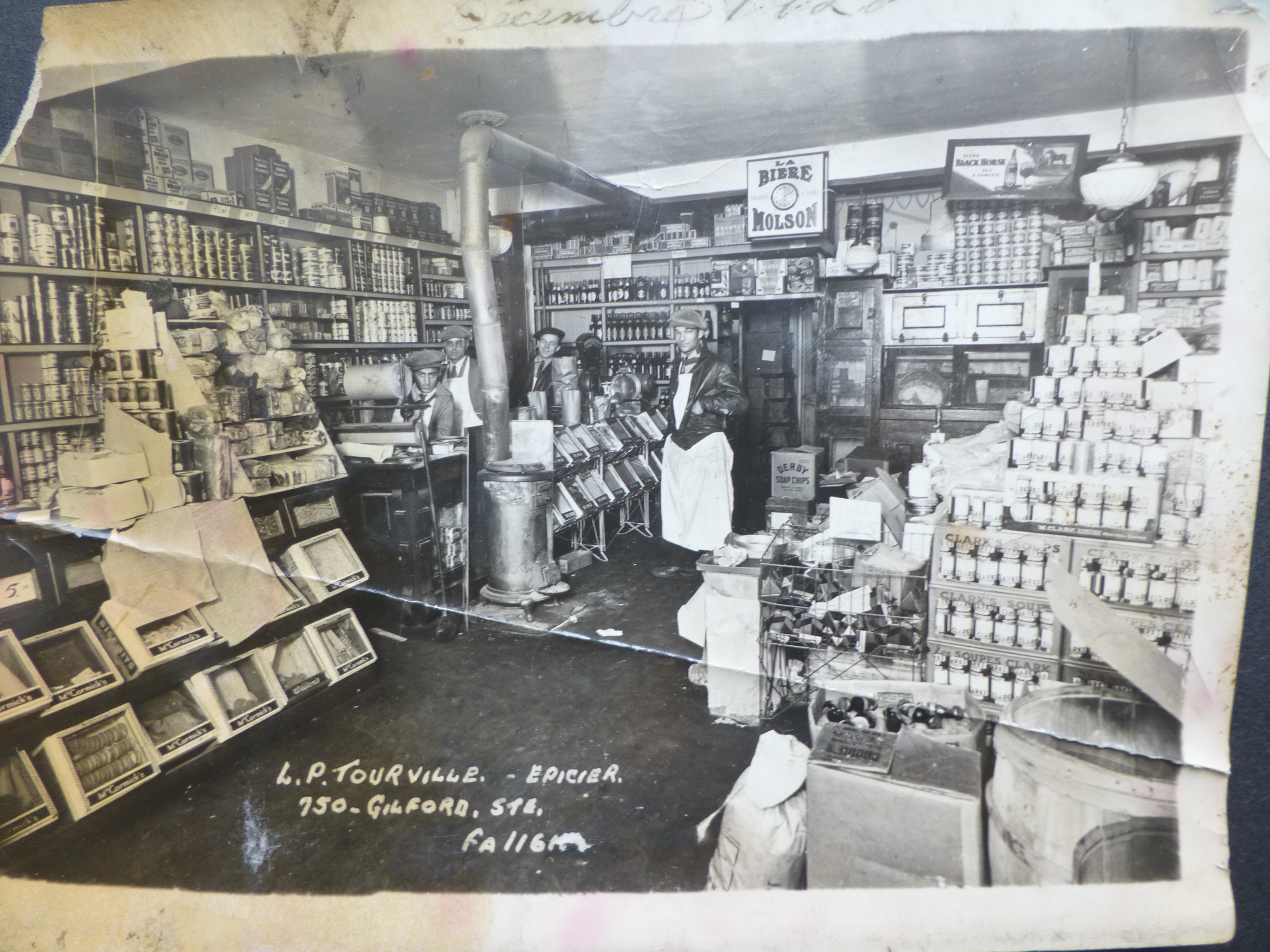
Although it is only in 1940 that Léopold Tourville (1899-1989) buys the property from his father, the son is already at the head of operations from the very beginning and assumes the trade of grocer. Two years after opening the store, Léopold marries Alvina Ethier and has a daughter, Monique, before losing his wife. Two sons, Jean-Pierre and Hubert, are born from his marriage to his second wife, Rolande Venne. The family lives on Laurier Avenue, close to the grocery store. Two of Léopold's sisters live above the grocery store at 752 Gilford Street. These women, who remained unmarried, play an important role in the success of the grocery store and are very present in the lives of their niece and nephews. When Léopold's second wife dies in 1960, the family is taken in by the two aunts. The busy work schedule of six days a week, running the grocery store, travelling at dawn to buy produce at the Bonsecours Market and later, at the Marché Central Métropolitain, long opening hours all these factors do not allow Léopold to overcome what is normal at the time and to learn to cook or run a household.
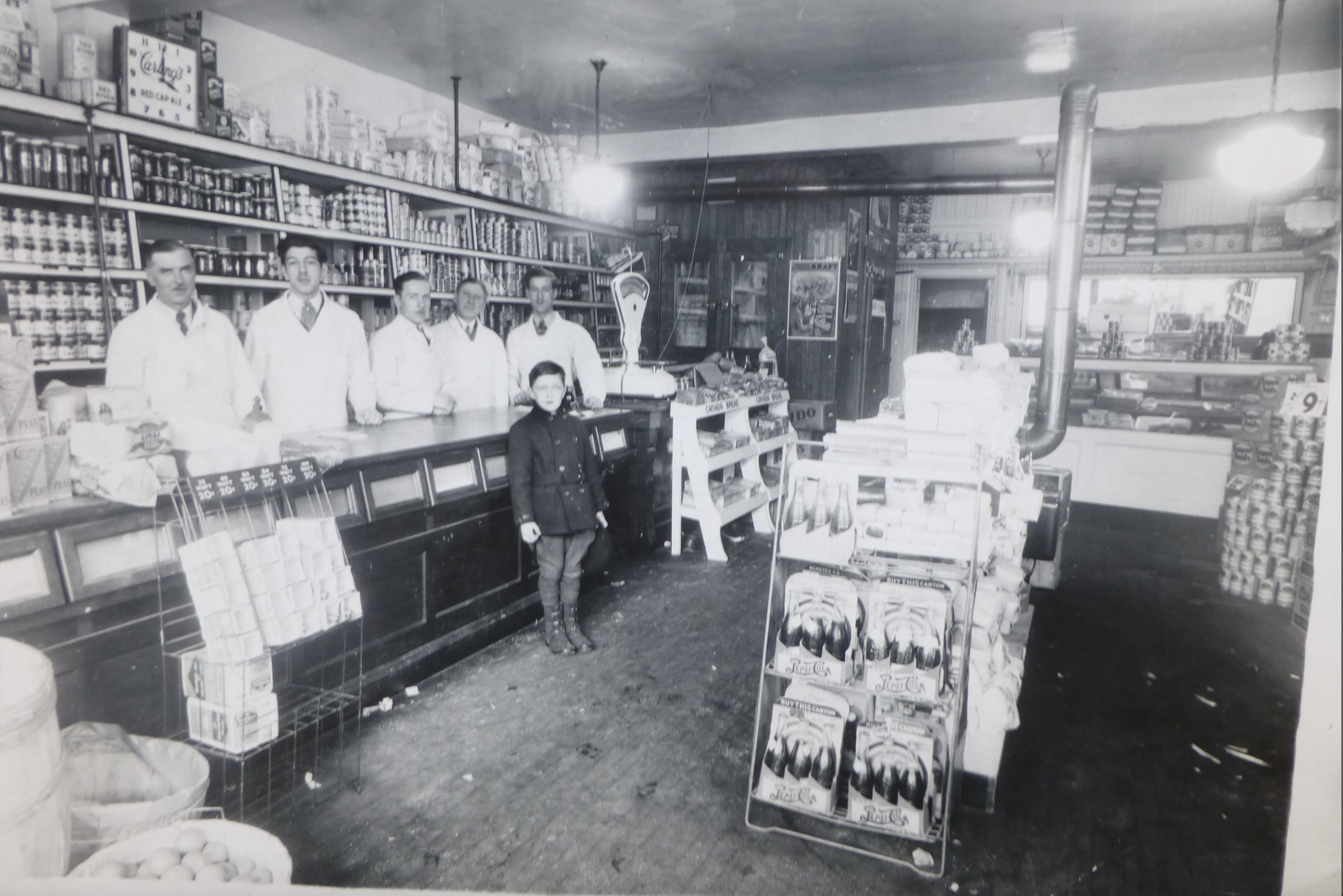 1944 The Marché Tourville has been refurbished over the years. The clock is sponsored by the Carling Brewery. Customers must still ask for their groceries and the employees use tongs to serve them. The meat counter is at the back. Léopold Tourville is on the far left. The fourth adult is probably Mr. Paquin, the butcher. The child is Léopold's son, Jean-Pierre, aged 6 and a half. Source: Tourville Family Fund.
1944 The Marché Tourville has been refurbished over the years. The clock is sponsored by the Carling Brewery. Customers must still ask for their groceries and the employees use tongs to serve them. The meat counter is at the back. Léopold Tourville is on the far left. The fourth adult is probably Mr. Paquin, the butcher. The child is Léopold's son, Jean-Pierre, aged 6 and a half. Source: Tourville Family Fund.
Family support is crucial to the success of the grocery store. Evelyne, Léopold's sister, plays a major role in managing the accounts and phone orders, supervising bike deliveries by the employees and opening the business in the mornings while her brother is out buying fresh produce. Léopold's three children all work at the grocery store. The eldest, Léopold's daughter, is responsible for the cash register on Fridays and Saturdays. Léopold's first son, Jean-Pierre, holds several positions over the years and eventually replaces his aunt as assistant manager before becoming manager. The second son, Hubert, recalls that by the time he was 8 or 9 years old, he was qualified to be a cashier. He managed small orders without ever making mistakes. Hubert also remembers the customers who "ran a tab" and who, for various reasons, paid by the week. He wrote down the amounts in a notebook and placed all the invoices in a metal shoebox.
Over time, Léopold Tourville participates actively in the development of his business and, to make it profitable, adapts to various fashionable methods. In particular, he is involved in the sale and advertising of many popular new products. In the 1930s, the grocery store is part of the list of sellers of Swift delicacies and huge box heads appear in La Presse for Easter, inviting the public to purchase hams and bacon from one of the participating merchants. His grocery store is also made popular by the sale of Maxwell House coffee, Wilsil bacon, the Belle Fermière Frankfurters, Gold Star stamps and even Marthe Miral's Brochurettes on the art of buying food and composing healthy menus.
In the December 1947 issue of Le Monde ouvrier, the following advertisement can be found: « L. Tourville Boucher-Épicier, Bière et Porter, 750 Gilford, coin Resther "Boucher-Épicier Butcher-Grocer Bière et Porter Ale and Porter" ». This advertisement indicates the sale of beers and porter. Some grocery stores, in addition to selling alcohol, had seats where their customers could drink alcohol, but this was not the case at Léopold Tourville's grocery store. He was well aware of the damage caused by alcohol, was very strict on the subject and even had to settle disputes with some of his butchers who drank and hid bottles of beer in the cold room. The bilingual advertisement is a sign of the English-speaking presence and although 98% of the neighbourhood's clientele spoke French, serving the few English-speaking customers in English was crucial for the business and the entire Tourville family could speak, serve customers and count in English.
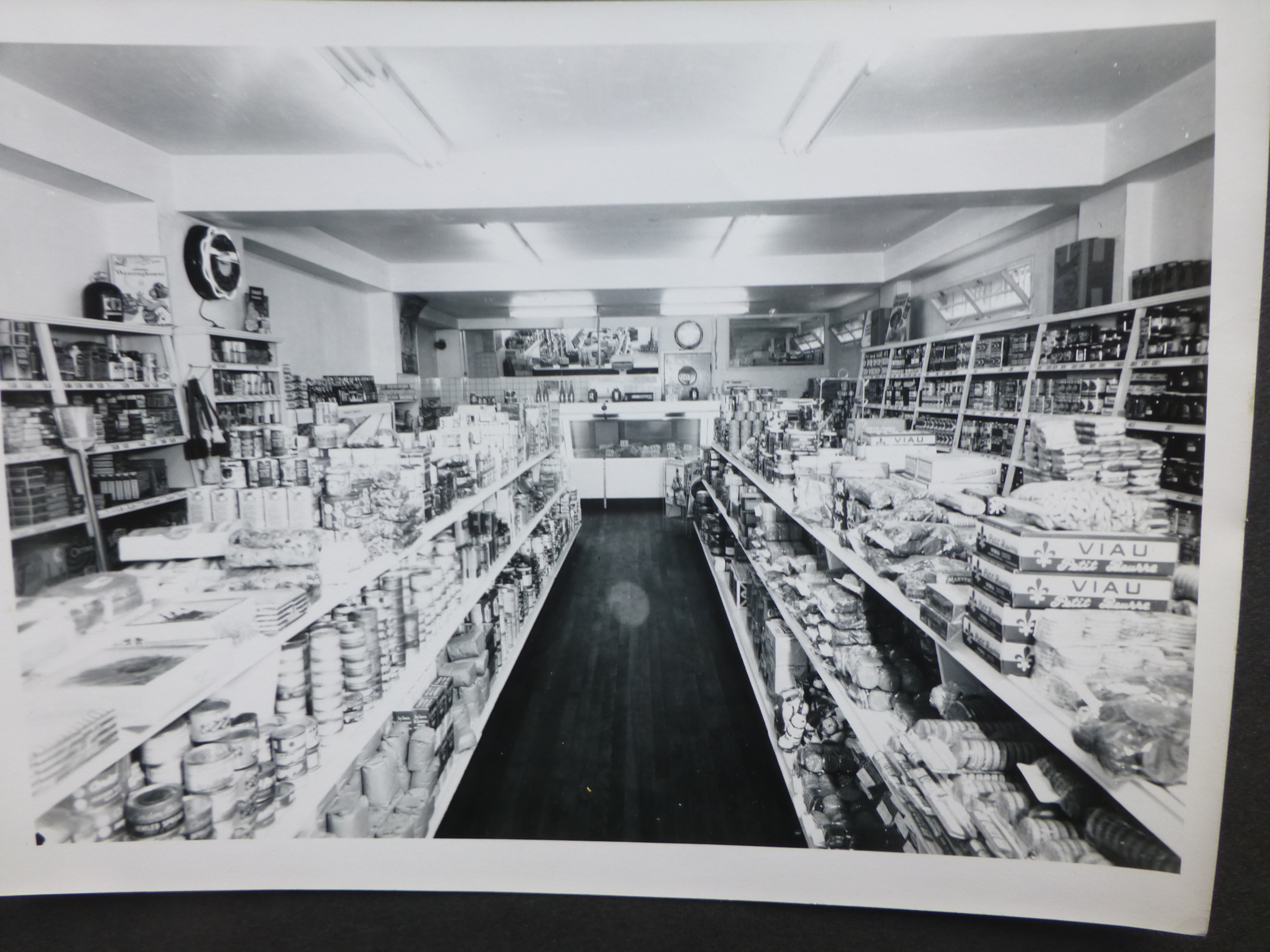
During the 1940s, the concept of a self-service grocery store, invented by Steinberg, becomes increasingly popular. On October 14, 1948, Léopold Tourville borrows $10,000 from Mr. Garbarino to completely refurbish his grocery store and offer the "Serve Yourself" concept. Moreover, the attraction of customers for big box stores and their attractive prices forces small grocery stores to adapt to compete with the large grocery chains. Many join forces to form buying groups. Léopold is one of the founding members of the Richelieu grocery stores, which becomes Métro-Richelieu, and later Métro. After seven years under the Richelieu banner, probably dissatisfied with the fees required to be part of the banner, Léopold tests several different banners: IGA, Coronet and then Excel.
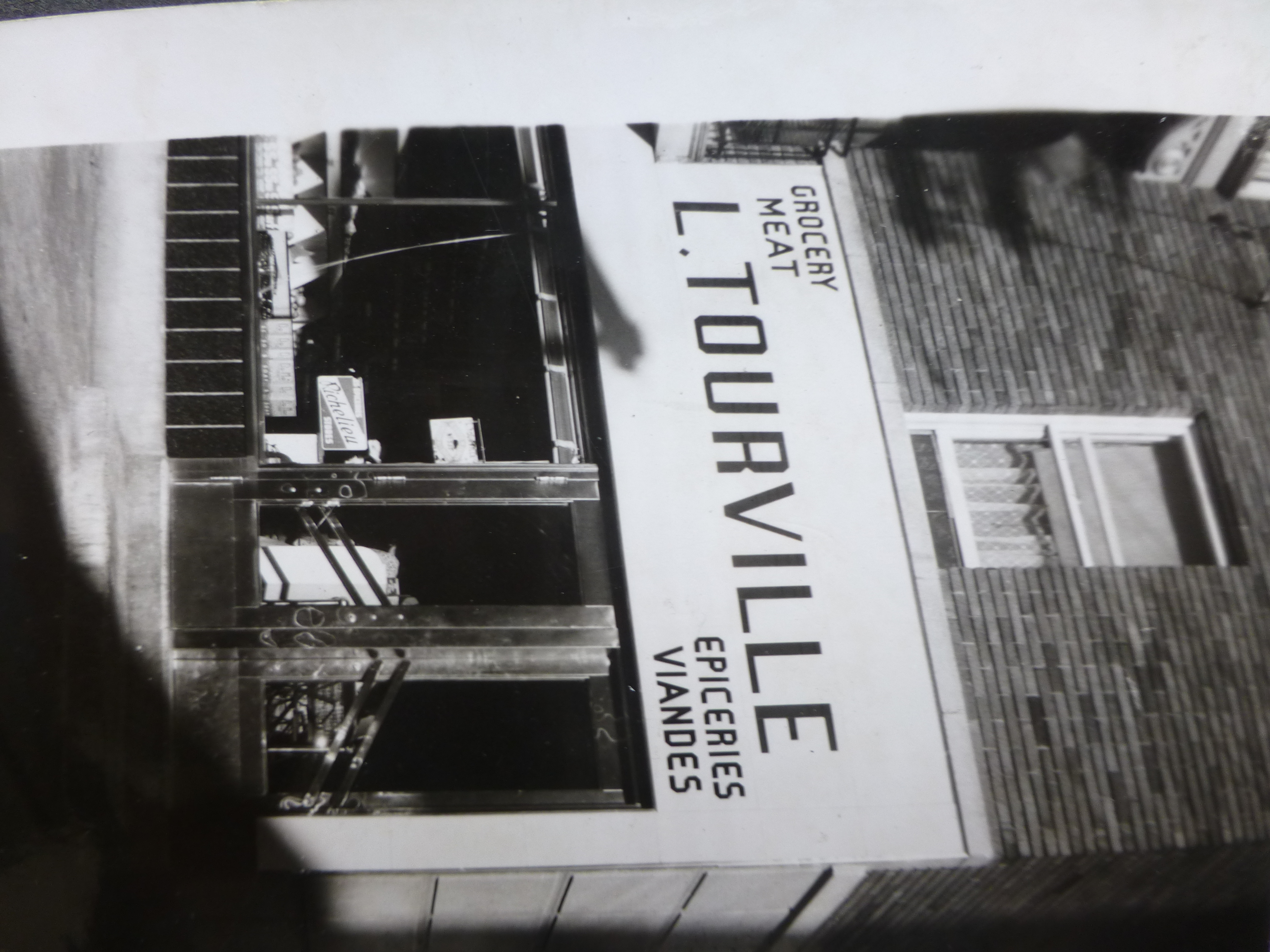
To survive and face the intense competition in the 1950s, grocers rely on what sets them apart: quality personalized service, knowledge of customer habits, telephone orders, home delivery, and credit. Knowing that women are the ones that do the buying, advertisers target them directly. For example, an advertisement published in La Presse on August 13, 1953, reads: « Oui madame, l'Épicier Richelieu situé près de chez-vous est l'homme en qui vous devez placer toute votre confiance, car c'est un homme qui a fréquenté la même école que vous ; qui a vécu dans la même atmosphère et c'est pourquoi ayant compris vos besoins et vos exigences, c'est l'homme tout désigné pour vous mieux servir » (You are right Madam, the Richelieu grocer close to your home is the man in whom you should place your entire trust, since this man went to the same school as you and has lived in the same neighbourhood as you. That's why, since he understands your needs and requirements, he is the best person to serve you well.)
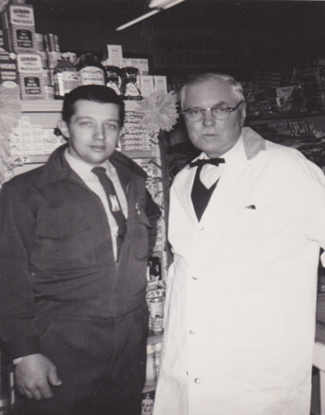
Circa 1957 Léopold Tourville with an employee who, among other things, delivered groceries. Source: Tourville Family Fund.
Jean-Pierre Tourville flirted with the idea of taking over his father's business. However, after trying for several years, he realizes that times have changed and that small independent grocery stores are not as popular as they used to be; for this reason, Jean-Pierre opts for a more profitable career and joins the Weston company. For their part, his sister Monique studies as a nurse and his brother Hubert opts for a career in computer science. On January 29, 1963, after 35 years of loyal service to a faithful clientele, Léopold Tourville sells his grocery store to Yvette Bouthillier, who runs the store for a year before selling it to Georges Gadbois.
The Brewery-Tavern-Bar Era (mid-1960s-2010)
Somewhere in the mid-1960s, 750 Gilford Street changes vocation to become a tavern. In 1967, in Le Devoir, Ms. Yvette Carter applies to the Régie des Alcools du Québec for a permit. In 1978, it is Gaston Philion's turn to apply for a permit, announcing a change of category: the tavern becomes La Brasserie 750 Inc. In 1991, it is changed into Bar 750 Inc. and later, Bar G.P.
The Organic Grocery Marché 3 Piliers (2010 to now)
On June 10, 2010, Mr. Guildor Paquet, owner of the building and of Bar G.P., sells the premises to Éric Aubut. In November of that same year, everything is ready for the opening of the Marché 3 Piliers. This marks the beginning of a new era for 750 Gilford Street, as the site returns to its original mission of feeding the neighbourhood. The Marché 3 Piliers offers a personalized atmosphere and products that meet the needs of the day. The three pillars of the name refer to an ecological basket, affordable prices, and social support for the local community. A wide selection of organic, local, natural and gluten-free products can be found at affordable prices. Located in the heart of the Plateau-Mont-Royal, the grocery store offers more than a hundred zero-waste products in returnable jars in addition to a selection of meals prepared on site, fresh fruit and vegetables, meat and fish, pharmacy products and more. In addition, people living in the neighbourhood can order online and be delivered by bike or electric car.
Léopold Tourville would be happy to see that neighbourhood grocery stores are once again on the rise and that in the place he cherished so much, a trendy grocery store now thrives. A lucky star is probably watching over this street corner!
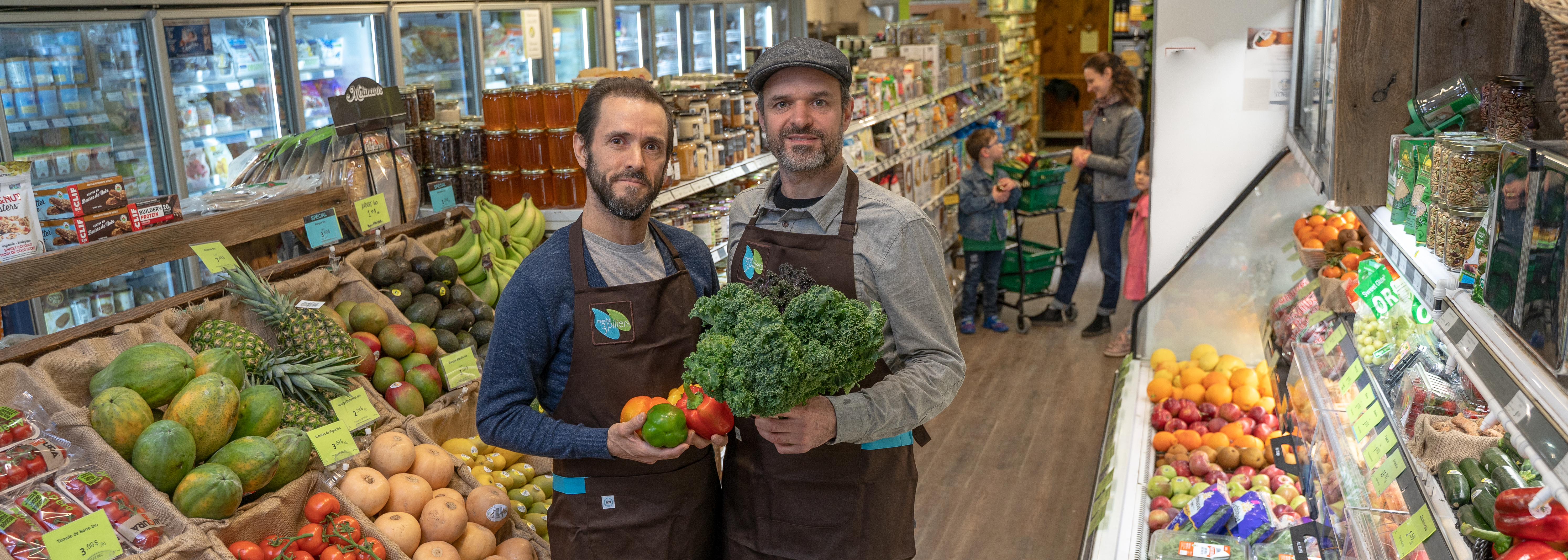
The Marché 3 Piliers. The two owners, Éric Aubut and Patrick Lévesque, in front of the abundance of fresh, frozen and refundable products. The atmosphere is warm and vibrant. Source: Marché 3 Piliers.
This article was made possible thanks to initial research carried out by André Boulanger, numerous testimonies from Hubert Tourville, son of Léopold Tourville, before being reviewed by the Tourville family. Thank you for your contributions.
References
Les Archives nationales - BAnQ BENOÎT, Michèle et Roger GRATTON, Pignon sur rue : Les quartiers de Montréal, Montréal, Guérin, 393p.
Commerces du coin - Publications de l'Écomusée du fier monde, 2,009. 38p.
DESCHAMBAULT Gabriel, « L'épicerie du coin de la rue », La Société d'histoire et de généalogie du Plateau-Mont-Royal, printemps 2014, p. 13.
TURCOT Laurent, « L'avènement des supermarchés au Québec », Le Journal de Montréal, 22 janvier 2,019. https://www.journaldemontreal.com/2019/01/22/lavenement-des-supermarches (30 avril 2023).
 Marché 3 Piliers
Marché 3 Piliers